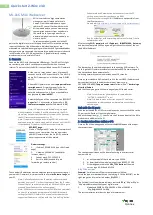
16
Sun Integrated Lights Out Manager 2.0 Supplement for Sun Fire X4170, X4270, and X4275 Servers • March 2009
2. To set the serial port owner, type:
->
set /SP/serial/portsharing/owner=host
By default,
owner=SP
.
Clear Server Faults
When a server component fails, the server generates a component-specific fault that
is captured by the ILOM SP. Some faults are cleared automatically when the failed
component is replaced, but faults generated for components that are
not
hot-
serviceable have to be cleared manually. You can use either the ILOM web interface
or the command-line interface (CLI) to manually clear faults.
For the Sun Fire X4170, X4270, and X4275 Servers, the following types of faults must
be cleared manually after the faulty component is replaced:
■
DIMM faults
■
CPU faults
■
Motherboard faults (when motherboard is not replaced)
■
PCIe faults
In addition, the following fault does not require replacement of a faulty part;
however, user action is needed to clear it:
■
fault.security.integrity-compromised@/sys/sp
This fault is generated when the server’s top cover is removed while the AC
power cords are still connected to the power supply, that is, power is not
completely removed from the server.
Caution –
If the
fault.security.integrity-compromised@/sys/sp
fault is
not cleared, the server SP will operate in a degraded mode and the server’s ability to
determine DIMM inventory and diagnose DIMM faults accurately is compromised.
For more information on the effects on the server when this fault is not cleared, see
the
Sun Fire X4170, X4270, and X4275 Servers Service Manual
(820-5830).
When clearing faults, give consideration to the following:
■
When clearing faults for memory DIMMs, note that the DIMM faults can be either
system wide (
/SYS/MB
) or on a per DIMM basis (
/SYS/MB/Pn/Dn
).
■
PCIe faults can cover one or more of the following components:
/SYS/MB/NETn
and
/SYS/MB/RISERn/PCIEn.
The procedure for clearing a fault differs depending on the type of fault:











































